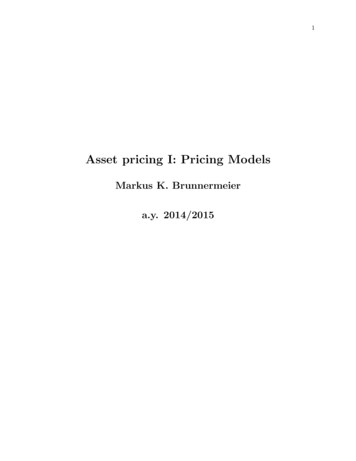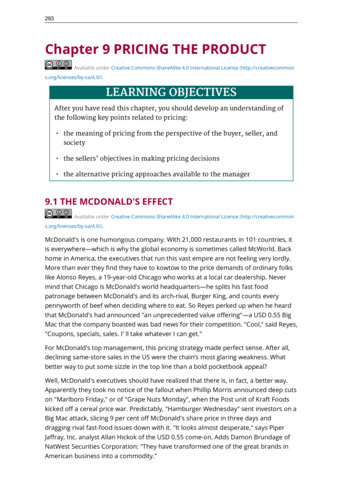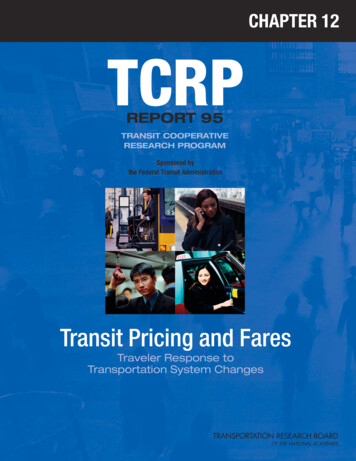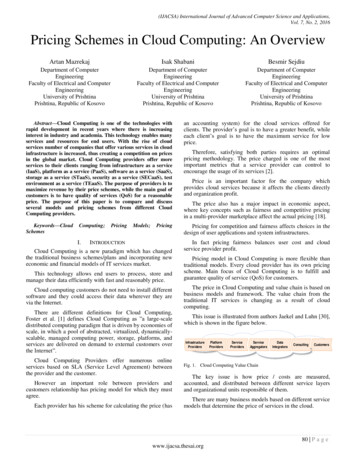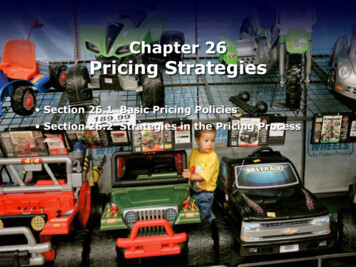
Transcription
Chapter 26Pricing Strategies Section 26.1 Basic Pricing Policies Section 26.2 Strategies in the Pricing Process
Basic Pricing PoliciesKey ngObjectives Name three pricing policies used to establish abase price Explain the two polar pricing policies forintroducing a new product Explain the relationship between pricing andthe product life cycleMarketing Essentials Chapter 26, Section 26.1
Basic Pricing PoliciesGraphic OrganizerUse a chart to take notes about the pricing policiesthat can affect the base price for a product.Marketing Essentials Chapter 26, Section 26.1
Basic Pricing ConceptsA major factor in determining the profitability ofany product is establishing a base price. There arethree methods of setting a product’s base price: Cost-oriented pricing Demand-oriented pricing Competition-oriented pricingMarketing Essentials Chapter 26, Section 26.1
Cost-Oriented PricingIn cost-oriented pricing, marketers first calculatethe costs of acquiring or making a product andtheir expenses of doing business, then add theirprojected profit margin to arrive at a price. Twocommon methods are markup pricing and costplus pricing.Marketing Essentials Chapter 26, Section 26.1
Cost-Oriented PricingmarkuppricingThe processwhere resellersadd a dollaramount(markup) to itscost to arrive ata price.cost-pluspricingMarkup pricing X has resellers adding a dollaramount (markup) to their cost to arrive at a price.It is used primarily by wholesalers and retailers.In cost-plus pricing X, all costs and expenses arecalculated, and then the desired profit is added toarrive at a price.All costs andexpenses arecalculated, andthen the desiredprofit is added toarrive at a price.Marketing Essentials Chapter 26, Section 26.1
Demand-Oriented PricingMarketers who use demand-oriented pricingattempt to determine what consumers are willingto pay for goods and services.The key to this method of pricing is theconsumer’s perceived value of the item.Marketing Essentials Chapter 26, Section 26.1
Demand-OrientedPricingThe demand for cell phoneservice has increasedtremendously in the pastyears.Marketing Essentials Chapter 26, Section 26.1
Competition-Oriented PricingMarketers may elect to take one of three actionsafter learning their competitors’ prices: Price above the competition Price below the competition Price in line with the competition (going-ratepricing)Marketing Essentials Chapter 26, Section 26.1
Establishing the Base PriceTo establish the base price, all three pricingapproaches can be used. Cost-oriented pricing Demand-oriented pricing Competition-oriented pricingMarketing Essentials Chapter 26, Section 26.1
Establishing the Base PriceThere are two ways to determine reseller prices: Work backward from the final retail price to findthe price for the wholesalers by subtracting themarkups for the channel members. Work forward from the manufacturer’s cost byadding markups for the channel members.Marketing Essentials Chapter 26, Section 26.1
Establishing the Base Price
Establishing the Base Price
Pricing Policies andProduct Life CycleA basic pricing decision is tochoose between a one-price policyand a flexible-price policy.Computers and otherelectronic appliances quicklygo out of date as newtechnology emerges.Marketing Essentials Chapter 26, Section 26.1
one-pricepolicyAll customers arecharged thesame price forthe goods andservices offeredfor sale.flexible-pricepolicyOne-Price Versus Flexible-PricePolicyA one-price policy X is one in which all customersare charged the same prices, quoted to them bymeans of signs and price tags without deviations.A flexible-price policy X is one in whichcustomers pay different prices for the same typeor amount of merchandise.A price policythat letscustomersbargain formerchandise.Marketing Essentials Chapter 26, Section 26.1
Product Life CycleProducts move through four stages, with pricingplaying a key role in each: Introduction Growth Maturity DeclineMarketing Essentials Chapter 26, Section 26.1
Product Life CycleskimmingpricingA pricing policythat sets a veryhigh price for anew product.penetrationpricingA pricing policythat sets theinitial price for anew product verylow.To introduce a new product, two methods may beused: Skimming pricing X: Setting a high price for anew product to capitalize on high demand. Penetration pricing X: Setting a low initialprice to encourage higher distribution andexposure.Marketing Essentials Chapter 26, Section 26.1
Product Life CyclePenetration pricing also requires a marketingstrategy that incorporates: Mass production Distribution PromotionMarketing Essentials Chapter 26, Section 26.1
Product Life CycleSales of products introduced with skimmingpricing should be monitored. Once sales beginto level off, the price should be lowered.Very little price change will be made in thegrowth state for products introduced withpenetration pricing.Marketing Essentials Chapter 26, Section 26.1
Product Life CycleThe marketer’s principal goal during the maturitystage is to stretch the life of a product. Some willreduce their prices or modify the original productas well as seek new target markets to maximizesales.Marketing Essentials Chapter 26, Section 26.1
SECTION 26.1 REVIEW
SECTION 26.1 REVIEW- click twice to continue -
Strategies in the Pricing ProcessKey Termsproduct mixpricingstrategiesprice liningbundle psychologicalpricingprestigepricingeveryday lowprices (EDLP)promotionalpricingObjectives Describe pricing strategies that adjust the baseprice List the steps involved in determining a price Explain the use of technology in the pricingfunctionMarketing Essentials Chapter 26, Section 26.2
Strategies in the Pricing ProcessGraphic OrganizerCreate an outline of this section to identify thestrategies for adjusting prices and the steps insetting prices.Marketing Essentials Chapter 26, Section 26.2
Adjusting the Base PriceTo adjust base prices, marketers may employ anyone or more of the following pricing strategies: Product mix pricing Geographical and international pricing Psychological and promotional pricing Discounts and allowancesMarketing Essentials Chapter 26, Section 26.2
Product Mix Strategiesproduct mixpricingstrategiesAdjusting pricesto maximize theprofitability for agroup ofproducts ratherthan just oneitem.Product mix pricing strategies X involveadjusting prices to maximize the profitabilityfor a group of products rather than for justone item. These strategies include: Price lining and bundle pricing Optional and captive product pricingMarketing Essentials Chapter 26, Section 26.2
Product Mix Strategiesprice liningA special pricingtechnique thatsets a limitednumber of pricesfor specificgroups or lines ofmerchandise.Price lining X is a special pricing technique thatsets a limited number of prices for specific groupsor lines of merchandise.Optional product pricing involves setting prices foraccessories or options sold with the main product.Marketing Essentials Chapter 26, Section 26.2
Product Mix StrategiesCaptive product pricing sets the price for oneproduct low but compensates for that low price bysetting high prices for the supplies needed tooperate that product.Marketing Essentials Chapter 26, Section 26.2
Product Mix Strategiesbundle pricingA pricing techniquein which a companyoffers severalcomplementaryproducts in apackage that is soldat a single price.With bundle pricing X, a company offers severalcomplementary products in a package that is soldat a single price that is lower than the cost ofbuying each item separately.Marketing Essentials Chapter 26, Section 26.2
Product Mix StrategiesgeographicalpricingA pricing techniquethat makes priceadjustmentsbecause of thelocation of acustomer fordelivery of products.Geographical pricing X refers to priceadjustments required because of the location ofthe customer for delivery of products. In thisstrategy, the manufacturer assumes responsibilityfor the cost and management of product delivery.Marketing Essentials Chapter 26, Section 26.2
Product Mix StrategiesInternational pricing must acknowledge: Economic conditions Exchange rate Shipping TariffsMarketing Essentials Chapter 26, Section 26.2
Segmented Pricing StrategiessegmentedpricingstrategyA pricingstrategy thatuses two or moredifferent pricesfor a product,even thoughthere is nodifference in theitem’s cost.A segmented pricing strategy X uses two ormore different prices for a product, even thoughthere is no difference in the item’s cost. Thisstrategy can help optimize profits and competemore effectively.Marketing Essentials Chapter 26, Section 26.2
Segmented Pricing StrategiesFour factors can help marketers use segmentedpricing strategies: Buyer identification Product design Purchase location Time of purchaseMarketing Essentials Chapter 26, Section 26.2
Psychological Pricing StrategiesPsychological pricing strategies are pricingtechniques that help create an illusion forcustomers. Some common ones are: Odd-even and prestige pricing Multiple-unit pricing Everyday low prices (EDLP)Marketing Essentials Chapter 26, Section 26.2
Psychological Pricing StrategiesOdd-even pricing involves setting prices that endin either odd or even numbers to convey certainimages. It is based on a psychological principlethat odd numbers convey a bargain image, whileeven numbers convey a quality image.Marketing Essentials Chapter 26, Section 26.2
Psychological Pricing StrategiesprestigepricingA pricingtechnique thatsets higher-thanaverage prices tosuggest statusand high qualityto the consumer.Prestige pricing X sets higher-than-averageprices to suggest status and high quality to thecustomer.Multiple-unit pricing suggests a bargain and helpsto increase sales volume.Marketing Essentials Chapter 26, Section 26.2
Psychological Pricing Strategieseveryday lowprices (EDLP)Consistently lowprices with nointention ofraising them orofferingdiscounts in thefuture.Everyday low prices (EDLP) X are low prices seton a consistent basis with no intention of raisingthem or offering discounts in the future. Thesehelp to reduce promotional expenses and lossesdue to discounting.Marketing Essentials Chapter 26, Section 26.2
Promotional PricingpromotionalpricingA pricingtechnique inwhich prices arereduced for ashort period oftime; generallyused inconjunction withsales promotions.Promotional pricing X is generally used inconjunction with sales promotions where pricesare reduced for a short period of time. Twocommon types are: Loss leader pricing Special-event pricingMarketing Essentials Chapter 26, Section 26.2
Promotional PricingLoss leader pricing is used to increase store trafficby offering very popular items for sale at belowcost prices.In special-event pricing, items are reduced in pricefor a short period of time, based on a specifichappening or holiday.Marketing Essentials Chapter 26, Section 26.2
Promotional PricingRebates are partial refunds provided by themanufacturer to consumers while coupons allowcustomers to take reductions at the time ofpurchase.Marketing Essentials Chapter 26, Section 26.2
Discounts and AllowancesDiscount pricing involves the seller offeringreductions from the usual price, and it can be donewith: Cash, quantity, and trade discounts Seasonal discounts and special allowancesMarketing Essentials Chapter 26, Section 26.2
Discounts and AllowancesQuantity discounts are rewards for consumers whobuy large amounts of a product. These discountscan be one of two types: Noncumulative CumulativeMarketing Essentials Chapter 26, Section 26.2
Discounts and AllowancesTrade discounts are the way manufacturers quoteprices to wholesalers and retailers, they are notactual discounts.Seasonal discounts are offered to buyers willing tobuy at a time outside the customary buyingseason.Marketing Essentials Chapter 26, Section 26.2
Discounts and AllowancesTrade-in allowances go directly to the buyer.Customers are offered a price reduction if they sellback an old model of the product they arepurchasing.Marketing Essentials Chapter 26, Section 26.2
The Pricing Process and RelatedTechnologyAs one of the four Ps of the marketing mix, pricingis one of the most flexible because pricingstrategies and prices can be changed quickly.Marketing Essentials Chapter 26, Section 26.2
Steps in Determining PricesThere are six basic steps that are used todetermine prices: Establish pricing objectives Determine costs Estimate demand and study competition Decide on a pricing strategy and set pricesMarketing Essentials Chapter 26, Section 26.2
Steps in Determining PricesTo set effective prices, the pricing objectives mustconform to the company’s overall goals. They mustalso be specific, time-sensitive, realistic, andmeasurable.Businesses must consider all of the costs involvedin making a product available for sale.Marketing Essentials Chapter 26, Section 26.2
Steps in Determining PricesTo estimate demand, marketers must researchhow the public will receive their product or servicebased on supply-and-demand theory and on theexceptions that occur because of demand elasticity.Businesses need to investigate what prices theircompetitors are charging for similar goods.Marketing Essentials Chapter 26, Section 26.2
Steps in Determining PricesWhen choosing a pricing strategy, be sure yourdecision conforms to your pricing objectives.The final step is setting the price. Marketers mustdecide how often they want to change their final,published prices.Marketing Essentials Chapter 26, Section 26.2
Pricing TechnologySmart pricing allows marketers to make intelligentpricing decisions based on an enormous amount ofdata that Web-based pricing technology makesavail
A pricing strategy that uses two or more different prices for a product, even though there is no difference in the item’s cost. Marketing Essentials Chapter 26, Section 26.2 . Segmented Pricing Strategies Four factors can help marketers use segmented pricing strategies: Buyer identification Product design Purchase location Time of purchase Marketing Essentials Chapter 26, Section .File Size: 525KBPage Count: 59

